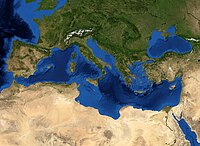
Photo from wikipedia
This study describes a new methodology for estimating gully widths based on their digitized borders. The procedure adapts a previous method developed to determine the mean displacement between two 3D… Click to show full abstract
This study describes a new methodology for estimating gully widths based on their digitized borders. The procedure adapts a previous method developed to determine the mean displacement between two 3D linestrings, considering them continuously, which represents an advance over conventional approaches. In addition to the calculation of the average horizontal distance, it also considers the calculation of widths by sections of a given length in order to analyze differences in their behavior compared to the results for the entire gully. The method is also adapted to multi-temporal studies to analyze the evolution of the gully by comparing width values from several dates. Application was carried out with a large number of linestrings representing gullies of a wide area of olive groves, which were digitized from orthoimages with 0.5 m resolution of two dates. The results demonstrate the feasibility of the proposed method for characterizing gullies and analyzing their evolution between several dates both completely and by sections, allowing the detection of critical areas of gully development. Therefore, these results can be used as input data to improve gully erosion susceptibility maps and to define zones for preventive or corrective actions.
Journal Title: Land
Year Published: 2023
Link to full text (if available)
Share on Social Media: Sign Up to like & get
recommendations!